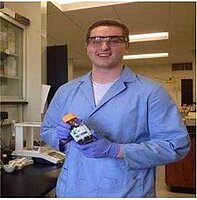Molecularly Imprinted Polymers for Phosphate Removal from Eutrophic Surface Water

Cody Ritt received his B.S. and M.S. in Civil Engineering from North Dakota State University (NDSU), where his research focused on developing phosphate-selective sorbents for mitigation of eutrophic surface waters and reuse as soil amendments to develop a more sustainable phosphate usage cycle. His intensive involvement in research at NDSU and STEM outreach in the Fargo community inspired him to pursue the National Science Foundation Graduate Research Fellowship (NSF GRF), which he received in 2016.
Now at Yale, his research currently focuses on modeling water permeation through 2D frameworks. Specifically, the goal of his work is to understand how much transport properties rely on flow through intersheet spacing as opposed to flow around the 2D nanosheets.
Fellow: Cody Ritt
Advisor: Achintya Bezbaruah
Molecularly Imprinted Polymers for Phosphate Removal from Eutrophic Surface Water
An unsustainable cycle of phosphorus (P) use has developed in modern society. Excessive amounts of phosphate rock are mined to meet growing agricultural demands with a rising global population. The vast majority of P finds itself permanently residing in surface waters at the end of this cycle, consequently devastating aquatic ecosystems through eutrophication.
The current research aims to develop a sorbent that can engender a more sustainable P reuse cycle by utilizing eutrophic surface waters as viable P resources. The goal was to develop a sorbent which can selectively recover P at low concentrations to mitigate eutrophication while also assessing its potential for reuse in soil amendments.
This research has identified molecularly imprinted polymers (MIPs) as possible sorbents to accomplish the aforementioned goal. Three MIPs were screened for viability by assessing their sorption capacities. After the initial screening, one MIP was selected for further study. The resulting MIP particles were characterized using scanning electron microscopy, electron dispersive spectroscopy, Fourier transform infrared spectroscopy, swelling analysis, and thermogravimetric analysis. The possible mechanisms of P removal were identified, thus providing foresight into the potential for future applications of MIPs as sorbents for P remediation.
Significance:
The P cycle in today’s society is unsustainable. To develop a more sustainable cycle, P needs to be reclaimed from non-conventional sources and reused for agricultural and industrial applications. There are other factors associated with the P cycle which need to be improved to develop a sustainable system, but recovery and reuse from surface wters has been identified as one of the methods to reduce human dependence on phosphate rock. In order to reach this goal, a technology must be developed that can successfully recover P from natural water bodies that will make P bioavailable for plants as fertilizer. Selective removal of P is necessary in order to make these water bodies usable sources of P recovery.
Without selective removal, P recovered from these sources runs the risk of having associations with constituents which are potentially toxic to crops in high concentrations. Therefore, a technology with selective removal of P is ideal for producing a usable recovery product. Many of the technologies available (i.e. bioremediation, chemical precipitation, etc.) cannot remove P below levels which are commonly found in eutrophic lakes (100 µg/L). The lack of this capability not only makes it extremely difficult to restore the health of important surface waters, but it also eliminates another major source of recoverable P for reuse in fertilizer applications. In addition to these two innately important criteria for successful P recovery and reuse, the technology must have sorption capacities that are competitive enough to be considered economically justifiable for use. A sorption capacity of approximately 10 – 26 mg P/g can be considered as competitive with many of the technologies currently available.
MIPs showed potential to provide selective removal of P at environmentally significant concentrations.
Significant Findings:
- MIP synthesized with the use of the [2-(Methacryloyloxy)ethyl]trimethylammonium chloride monomer showed to have competitive sorption capacities. Increasing the template: monomer ratio was found to increase the sorption capacity. Polymer MM12 had the greatest sorption capacity found (~28 mg P/g) due to having the highest template: monomer ratio of (12:4).
- MIPs studied did not possess full-selectivity toward phosphate removal as interference from coexisting anions was found. This is likely attributed to the nature of the positively charged polymer surface to attract all anions at the pH of interest.
- MM12 exhibited partial-selectivity toward phosphate. MM12 selectively sorbed phosphate after positively charged sorption sites had been saturated with other anions.
- Chemical binding of phosphate in polymer matrix was observed, confirming that electrostatic attraction is not the only mode of P removal. This chemical binding is likely located within the imprinted cavities.
- Sorption capacity of MM12 severely limited by the concentration of P present. Lower concentrations of P witnessed immediate removal until a pseudo-equilibrium was reached. No further P was removed after reaching pseudo-equilibrium, regardless of increased contact time or stirring. This phenomenon is likely attributed to the development of an electric double layer on the surface of the charged polymer.
- Electrostatic attraction was deemed as the predominant phosphate removal mechanism.
Peer Papers:
Hossain, M.E., Ritt, C.L., Almeelbi, T., Bezbaruah, A.N., Biopolymer Beads for Aqueous Phosphate Removal: Possible Application in Eutrophic Lakes, Journal of Environmental Engineering, 2017.
Conference:
Hossain, M.E., Almeelbi, T., Ritt, C., Bezbaruah, A.N., Biopolymer Beads for Aqueous Phosphate Removal: Possible Application in Eutrophic Lakes, Proc. World Environment and Water Resources Congress 2014, American Society of Civil Engineers’ Environment and Water Resources Institute, Portland, OR, June, 2014 (also accepted for oral presentation)
Ritt, C. Removal of Nitrosamines from Water with the use of Polymers, Presented to International Prairie Student Conference: Water Treatment Session, August, 2016 (oral presentation)
Ritt, C. Advancements of Phosphate Removal using Metal Cross-linked biopolymer beads, Presented to North Dakota State University’s Environmental Engineering Class, April, 2016 (oral presentation)
Ritt, C. Optimization of Aqueous Phosphate Removal using Modified Biopolymer Beads, Presented to: NDSU EXPLORE, November, 2014 (oral presentation)
Ritt, C. Aqueous Phosphate Removal with Metal Cross-linked Biopolymer: Adsorption and Interference Studies, Presented to: International Prairie Student Conference: Nanotechnology Session, August, 2014 (oral presentation)
Ritt, C. Use of Biopolymer Entrapped NZVI and Bacteria for Effective Removal of Sulfate from Surface Waters, Presented to: American Society of Civil Engineers’ Environment and Water Resources Institute: Nanotechnology Session, June, 2014 (oral presentation)
Ritt, C. Making Beads from Alginate for Nanotechnology Applications, Workshop on Nanotechnology, Presented to: International Conference on Natural Resource Management: Global Trends, Cotton College University, India, January, 2014 (real time video presentation from Fargo)
Ritt, C. Cross-linked Biopolymer Beads for Aqueous Phosphate Removal, Presented to: North Dakota State University’s Environmental Engineering Class, January, 2014 (oral presentation)

Achintya Bezbaruah
Civil & Environmental Eng.
Office: Civil/Ind Eng 201G
Telephone: 701-231-7461
Email: a.bezbaruah@ndsu.edu


